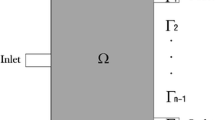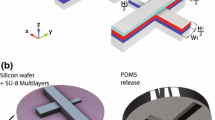Abstract
A geometric design for a microfluidic chip using numerical simulation is presented. Finite element method was employed in order to design the microchannel configuration for a microfluidic chip array. The effect of geometry on the thermal response at the interface between the microfluidic chips and an integrated system, such as a micro-electronic device, was investigated. Dimensionless design charts, obtained from the parametric models, demonstrated that a compromise between a maximum heat transfer and a minimum interface temperature was achieved with an equilateral triangle cross-section at a microchannel spacing to width ratio of two. The transient response of the microfluidic chip implied that the transient analysis corresponded to the steady state results under different boundary conditions.
Similar content being viewed by others
References
T. P. Cotter, Principles and prospects for micro heat pipes, 5th International Heat Pipe Conference, Tsukuba, Japan (1984) 328–335.
P. Sabounchi, et al., Soft-state biomicrofluidic pulse generator for single cell analysis, Applied Physics Letters, 88(18) (2006) 183901.
A. Hiratsuka, et al., Organic plasma process for simple and substrate-independent surface modification of polymeric BioMEMS devices, Biosensors and Bioelectronics, 19(12) (2004) 1667–1672.
A. Faghri, Heat pipe science and technology, Taylor & Francis, Washington, DC (1995).
C. W. Liu, C. Gau and B. T. Dai, Design and fabrication development of a micro flow heated channel with measurements of the inside micro-scale flow and heat transfer process, Biosensors and Bioelectronics, 20(1) (2004) 91–101.
S. Launay, V. Sartre and M. Lallemand, Experimental study on silicon micro-heat pipe arrays, Applied Thermal Engineering, 24(2–3) (2004) 233–243.
L. J. Brognaux, et al., Single-phase heat transfer in micro-fin tubes, International Journal of Heat and Mass Transfer, 40(18) (1997) 4345–4357.
J. Li, G. P. Peterson and P. Cheng, Three-dimensional analysis of heat transfer in a micro-heat sink with single phase flow, International Journal of Heat and Mass Transfer, 47(19–20) (2004) 4215–4231.
M. Ghajar, J. Darabi and N. Crews Jr, A hybrid CFDmathematical model for simulation of a MEMS loop heat pipe for electronics cooling applications, Journal of Micromechanics and Microengineering, 15(2) (2005) 313–321.
S.-W. Kang, S.-H. Tsai and M.-H. Ko, Metallic micro heat pipe heat spreader fabrication, Applied Thermal Engineering, 24(2–3) (2004) 299–309.
C. H. Shen and C. Gau, Thermal chip fabrication with arrays of sensors and heaters for micro-scale impingement cooling heat transfer analysis and measurements, Biosensors and Bioelectronics, 20(1) (2004) 103–114.
D. M. Leatzow, et al., Attachment of plastic fluidic components to glass sensing surfaces, Biosensors and Bioelectronics, 17(1–2) (2002) 105–110.
D. Therriault, S. R. White and J. A. Lewis, Chaotic mixing in three-dimensional microvascular networks fabricated by direct-write assembly, Nature Materials, 2(4) (2003) 265–271.
T. Kimura, et al., Thermal conductivity and RF signal transmission properties of Ag-filled epoxy resin, New Orleans LA, United States, (2003) 1383–1390.
J. F. Mark, et al., Array Biosensor: Optical and Fluidics Systems, Biomedical Microdevices, V1(2) (1999) 139–153.
B. Suman and N. Hoda, Effect of variations in thermophysical properties and design parameters on the performance of a V-shaped micro grooved heat pipe, International Journal of Heat and Mass Transfer, 48(10) (2005) 2090–2101.
B. Suman, S. De and S. DasGupta, A model of the capillary limit of a micro heat pipe and prediction of the dry-out length, International Journal of Heat and Fluid Flow, 26(3) (2005) 495–505.
H. B. Ma and G. P. Peterson, Experimental investigation of the maximum heat transport in triangular grooves, Transactions of the ASME. Journal of Heat Transfer, 118(3) (1996) 740–746.
G. P. Peterson, A. B. Duncan and M. H. Weichold, Experimental investigation of micro heat pipes fabricated in silicon wafers, Journal of Heat Transfer, Transactions ASME, 115(3) (1993) 751–756.
J. T. Dickey and T. T. Lam, Impact of channel geometry on heat transfer in microchannel for high density electronics cooling, Kauai, Hi, United States (2001) 681–686.
J. Li and G. P. Peterson, Geometric optimization of a micro heat sink with liquid flow, IEEE Transactions on Components and Packaging Technologies, 29(1) (2006) 145–154.
P. M. Y. Chung, et al., Two-Phase Flow Through Square and Circular Microchannels-Effects of Channel Geometry, Journal of Fluids Engineering, 126(4) (2004) 546–552.
L. Zhang, et al., Phase change phenomena in silicon microchannels, International Journal of Heat and Mass Transfer, 48(8) (2005) 1572–1582.
H. B. Ma and G. P. Peterson, Temperature variation and heat transfer in triangular grooves with an evaporating film, Journal of Thermophysics and Heat Transfer, 11(1) (1997) 90–97.
P. C. Stephan and C. A. Busse, Analysis of the heat transfer coefficient of grooved heat pipe evaporator walls, International Journal of Heat and Mass Transfer, 35(2) (1992) 383–391.
B. Suman and P. Kumar, An analytical model for fluid flow and heat transfer in a micro-heat pipe of polygonal shape, International Journal of Heat and Mass Transfer, 48(21–22) (2005) 4498–4509.
M. Rahmat, Geometric optimization for a thermal microfluidic chip, in Mechanical Engineering. 2007, McGill University: Montreal. 124.
I. Tiselj, et al., Effect of axial conduction on the heat transfer in micro-channels, International Journal of Heat and Mass Transfer, 47(12–13) (2004) 2551–2565.
T. Motoyama and R. Hackam, Effect of temperature and water salinity on hydrophobicity of epoxy resin, Kitchener, ON (2001) 157–160.
Y. A. Cengel, Heat Transfer: a practical approach, Second ed, McGraw-Hill, New York (2003).
N.-C. Tsai and C.-Y. Sue, SU-8 based continuous-flow RTPCR bio-chips under high-precision temperature control, Biosensors and Bioelectronics, 22(2) (2006) 313–317.
Author information
Authors and Affiliations
Corresponding author
Additional information
This paper was recommended for publication in revised form by Associate Editor Ji Hwan Jeong
Meysam Rahmat Received his B.Sc. in Mechanical Engineering from Iran University of Science and Technology (IUST) in 2004. He completed his Master of Engineering in the department of Mechanical Engineering at McGill University, and started his Ph.D. in the same department in 2007.
Pascal Hubert (Ph.D. Metals and Materials Engineering, The University of British Columbia) holds a Canada Research Chair in Advanced Composite Materials. He is an associate professor at McGill University in the Department of Mechanical Engineering (since September 2002). Dr. Hubert has 90 refereed journal and conference publications with over 20 publications in the area of nanocomposites and on the processing and performance of composite materials.
Rights and permissions
About this article
Cite this article
Rahmat, M., Hubert, P. Geometric optimization for a thermal microfluidic chip. J Mech Sci Technol 24, 2143–2150 (2010). https://doi.org/10.1007/s12206-010-0710-z
Received:
Revised:
Accepted:
Published:
Issue Date:
DOI: https://doi.org/10.1007/s12206-010-0710-z




